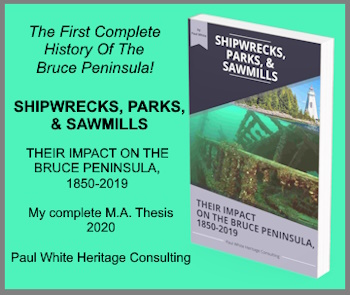My newest book, "Hockey In The Forest City: London's Story" SEE IT HERE!
A Harbinger of Spring
on the Great Lakes
in Pioneer Times
A harbinger of spring on the Great Lakes in pioneer times, was the eagerly awaited news that a lighthouse had been lit and shipping traffic could begin sailing from port to port.
In the early days of settlement, the arrival of spring was eagerly awaited by the pioneers. The lack of effective overland routes to the more settled regions of the colony left the Owen Sound area virtually isolated from the rest of the world during the winter months. By the month of March, the pioneer’s larders were close to being empty and the commercial traders' store rooms were in a similar state. Everyone was awaiting the arrival of the first vessels laden with produce.
The first ships of the season faced difficult conditions. Fierce storms made sailing treacherous. The rugged shoreline made finding a safe haven as treacherous as the swelling waters, winds, and torrential rains, and snow from which they which they were trying to escape and took a heavy toll on the early maritime traffic. As the population of the area increased so did the traffic on the lakes. To help alleviate the dangers to the sailors and their ships, lighthouses were erected on both the Huron and Georgian shorelines.
The first lighthouses on Lake Huron were erected on the American shoreline. The first, the Fort Gratiot Light, at the entrance to the St. Clair River went into service in 1825. By 1840 there were four American lighthouses on Lake Huron. The first Canadian lighthouse on that lake went into service in 1847 at Goderich.
The arrival of rail connections to the Georgian Bay shores in the 1850s and the opening of the canal at Sault Ste. Marie in 1855, increased maritime traffic and signaled the need for lighthouses, especially in the Tobermory area. In 1859 the Cove Island light went into service. In 1870 a light was erected on Lonely Island, and in 1897 another was installed on Flowerpot Island. It was hoped that these beacons would provide a safer path through the treacherous waters around the tip of the Bruce Peninsula.
The Cove Island lighthouse was one of six completed during the rush to improve navigation on Lake Huron and Georgian Bay in the 1850s. The other five were at Point Clarke near Kincardine, Chantry Island at Southampton, Griffith Island at the entrance to Colpoys Bay, Christian Island, and Nottawasaga Island.
These lighthouses were constructed simultaneously by a Thorold contractor John Brown. They were simple structures. But, due to their remote locations, not easily built. The decision to build them was not only beneficial to navigation, but also proved to be a boon to entrepreneurs and workers in the area. Quarries were opened at Owen Sound, Main Station Island, and Inverhuron. The stone for the base courses and the exterior facing of the lighthouses came from the Owen Sound quarry and the cement was shipped in from Brown’s mill at Thorold.
Harbinger of Spring on Georgian Bay
In the Owen Sound area, the Presqu’ile lighthouse was an important maritime structure. It was the last light to be extinguished each autumn and the first lit each spring on Owen Sound. News that it was in operation received front page coverage in both Wiarton and Owen Sound newspapers each spring!
Although these lighthouses were built to help mariners sail safely through treacherous water there were still many shipping disasters in the area. But the lighthouses were more than a device for improving maritime safety. The news that the lighthouses were operational was also a much-awaited harbinger of spring for most of the settlers in the Grey and Bruce area.
A version of this story first appeared in my Local History column in the Owen Sound Sun Times.
Georgian Bay Shipping
List of Lighthouses on the Great Lakes: If you have names and/or pictures of Great Lakes Lighthouses please submit them along with details of their location.
Georgian Bay Ships: A List of all the ships that sailed on Georgian Bay until the 1960s. This list is not complete. If you know of a ship that sailed the waters of Georgian Bay please contact me with information about that vessel, and, if you have a picture that I could post with it, that would be much appreciated.
1885: A Memorable Summer Job for Owen Sound teenage boys on the Great Lakes would have historic importance, not mention a possible exciting career opportunity.
Hindman Transportation Company was a well-known Great Lakes shipping company for many years. Here you will find pictures of many of the Hindman ships
Owen Sound Harbour – A Photographic History, by Robert A. Cotton is a book that interests my historiographical curiosity.
Commercial Great Lakes Fishing It is probably safe to suggest that the commercial fishing industry was an important part of the early growth of this region.
A Georgian Bay fishing vacation has long been a popular attraction in the Bruce Peninsula region. During fishing derbies, the regional waterways are dotted with fishing boats of all shapes and sizes.
The Georgian Bay Mackinaw, designed by William Watts of Collingwood is an example of a Georgian Bay innovator creating a vessel to service the needs local mariners.
Great Lakes fishing is an asset that is protected and developed, not only for its economic potential but also for those who just enjoy spending a day by the side of a river or in small fishing boats trying to catch “the big one”!
Great Lakes Fishing History is not without its controversy. The impact of the fishing industry was such that it played an important role in the development of communities along the Georgian Bay and Lake Huron shoreline.
Georgian Bay Travel Before the Winter Freeze-Up could be a dangerous time for mariners in the early years in this region.
A Harbinger of Spring on the Great Lakes in pioneer times, was the eagerly awaited news that a lighthouse had been lit and shipping traffic could begin sailing from port to port.
Lumber Hookers Lumber hookers and tugs were an important innovation to improve the transportation of lumber on Georgian Bay.
Mapmakers on Georgian Bay were also explorers. They mapped the Georgina Bay shoreline noting safe harbours, dangerous reefs and other guides for sailors and pioneer settlers looking for a place to call home.
Paddling Georgian Bay & Pondering: traversing parts of this great waterway in a canoe leads one to wonder about the ships of a bygone era battling the rough seas they encountered.
Parry Sound Shipping History: The Parry Sound area has always been connected to the southern regions of the Province of Ontario by a system of good roads. Or has it?
Parry Sound’s shipping history 2 is more than the tragic sinking of the Waubuno or the later catastrophe surrounding the sinking of the Asia.
Sailing Season Closing: A Frantic Time on Peninsula as ships raced from port to port delivering and picking up passengers and produce before the waterways froze.
Ship Captain Andrew Port was not only a dynamic and brave Georgian Bay mariner, he was a personal favourite historical character of mine.
Ships Stuck in Ice: The Oak Glen was icebound in 1996 but this sailing hazard has been impacting vessels on Georgian Bay since the beginning of time.
Lake Huron shipwrecks, the Hibou often occurred in the Georgian Bay region of that Great Lake due to the often violent waters that could strike unsuspecting vessels like the Hibou.
Shipwrecks: The "Asia" wrecked off the eastern coast of Georgian Bay taking all but two of the more than 100 passengers to a watery grave.
Masters, Mates, and Pilots Association created its first Canadian chapter on Georgian Bay, providing maritime safety education, and other seafaring issues to better inform its membership.
Pioneer Travel Aboard the Fly Tells the story of a sailing vessel as the tenuous link between survival and death in a pioneer settlement in the 1840's in Upper Canada.
Sailing Stories: the Captain Who Smelled his way into Port The Captain Who Smelled his Way into Port details how pioneer seamen on Georgian Bay safely sailed the rough waters without the aid of the modern technological tools so readily used by today's mariners.
Sailing Story: The Voyage of the Prince Alfred the incredible voyage of the Prince Alfred, fraught with danger for both vessel and the crew in the winter of 1880.
Shipbuilding As the southern Georgian Bay region became more populated shipping traffic increased to meet the needs of an expanding market place.
The Summer of 1844 was No Picnic for the early settlers in the pioneer area near what would become Owen Sound on Georgian Bay.
The CPR Grain Elevator Fire of 1911 spelled the end of Owen Sound's role as the eastern terminus of the CPR Great Lakes Fleet.
Georgian Bay shipping occurred long before the first Europeans paddled these waters. But the fur and timber trades opened Georgian Bay to shipping in a big way!






